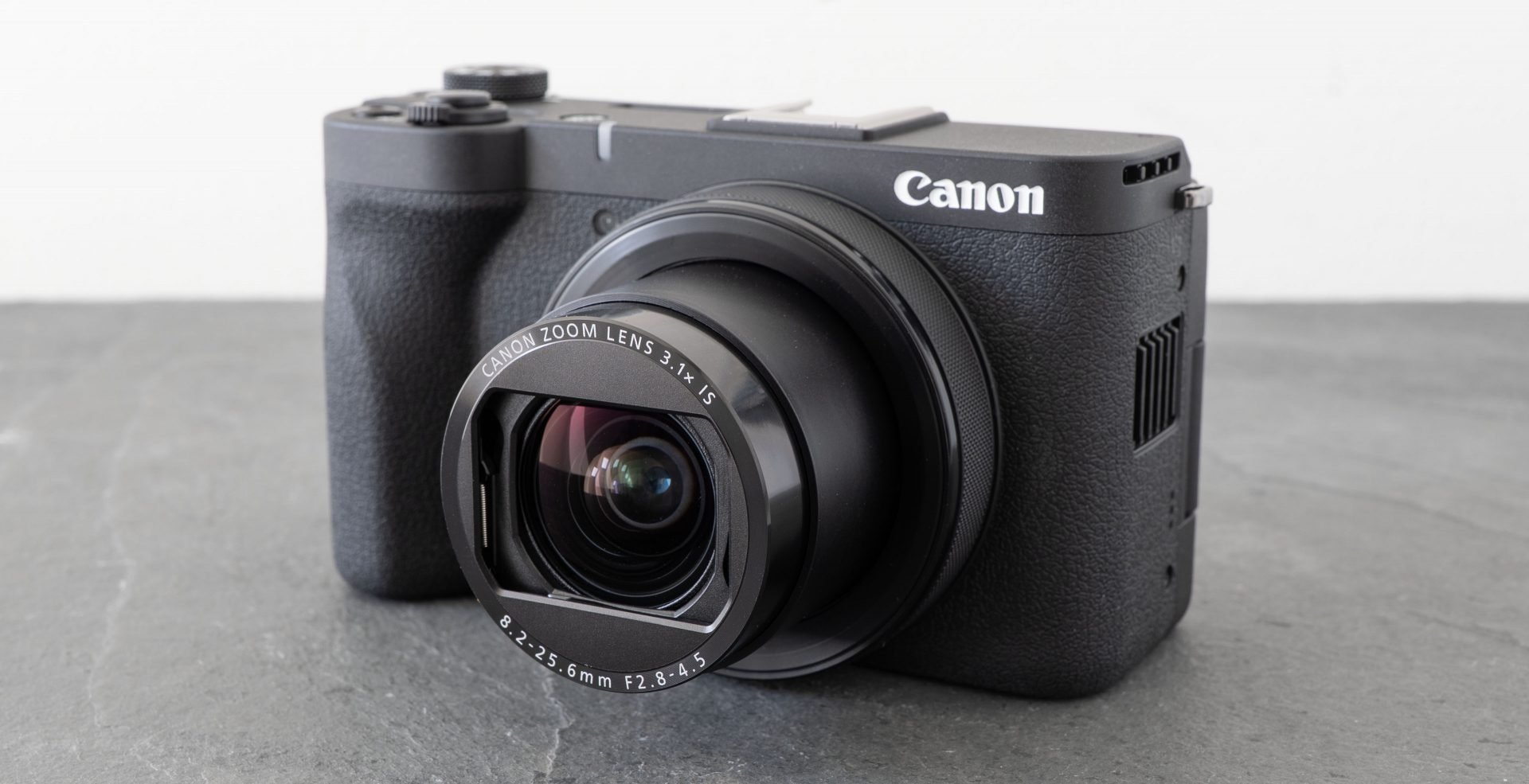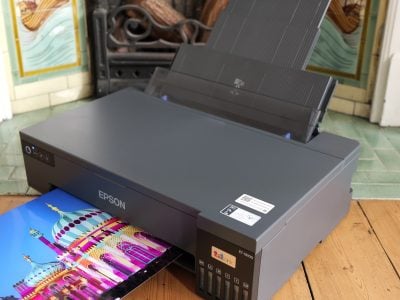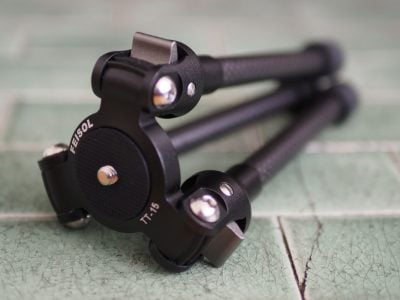Canon PowerShot V1 review
-
-
Written by Gordon Laing
Intro
The Canon PowerShot V1 is a fixed lens compact with a large sensor aimed at video creators. It’ll take 22 Megapixel photos, but as you’ll learn, many of the design, feature and control decisions are aimed at video users first. After all, the V in the name stands for video, so don’t expect a photo-oriented camera here.
Officially launched in March 2025 alongside the EOS R50 V, the two cameras build-upon the V series that started with the PowerShot V10. All are aimed at video creators but with different feature sets. As such I wouldn’t be surprised to see further V-series products in the future. In this respect it’s similar to Sony’s ZV series.
In terms of price and features, the V1 is positioned above the popular G7X Mark III from 2019. The G7X III officially remains on sale, although low supply and high demand for all G-series compacts ironically means the new V1 could actually work out cheaper compared to the scalpers on eBay. Let’s hope Canon can make enough of them and put an end to ridiculous opportunists. My full review is in the video below, but keep scrolling if you prefer to read the written highlights!
Measuring 118x68x53mm and weighing 426g including battery, the V1 is chunkier all-round compared to the G7X III, but should still squeeze into larger pockets and is just fine carried in a bag. As far as I know, the V1 is not weather-sealed. Viewed from the front, the V1 is styled like the G7X, but with a taller grip that should fit three fingers with your index hovering over the shutter button.
When powered-up, the lens covering opens with the barrel quickly extending by about 30mm and the camera ready for action in about one and a half seconds. Powering back down is equally quick, making it feel much more responsive than some earlier compacts. Also note the free-spinning customisable control ring around the lens barrel.
Turning to the top surface, you’ll note unlike the G7X, there’s no popup flash, while the Multi-function shoe in the middle lacks the pins for traditional flashguns. I think there’s shoe adapter for flashes, but this is one of the many indicators the V1 is aimed more for video than hybrid or photo use. This shoe is meant for more for video-based accessories like microphones To the right is the built-in microphone and Canon considerately includes a muffler accessory that slides onto the shoe and protects it from wind. It’s similar to an approach previously offered by Sony and as you’ll hear in my demos later, can be quite effective.
The camera’s powered-up for shooting using a small button towards the front, while a collar switch around the mode dial sets it to record photo or video. Meanwhile a spring-loaded collar around the shutter button operates the motorised zoom, and there’s a dedicated button for video to its right. Note the small mode dial with the usual exposure, custom, scene and effect positions. You can also power up the camera straight into playback by pushing and holding the play button – this avoids the lens opening and extending.
Round the back the V1 is dominated by a 3in screen with 1.04 million dots; this doesn’t sound particularly detailed, but it looks bright and crisp in use. Good thing too, as in the absence of a viewfinder, it’s the only means of composition. Now I realise this is a video-oriented camera, and keep getting told the target audience doesn’t use viewfinders, but personally I find them invaluable even when setting up or reviewing videos. It is what it is though, but I do wish Canon would make an EVF accessory for the Multi-interface shoe, or offer a photo-oriented version of the V1 in the future. Who’s with me? As you’d expect, the screen is side-hinged, flipping out and twisting up or down to face you or for easier composition at high or low angles, or back on itself for protection.
Turning to the left side, you’d expect to find the ports, but instead there’s a vent. This draws air into the V1 using a fan for active cooling, with warm air exiting through the smaller vents above and on the upper left side of the rear. This system effectively takes the place a popup flash or viewfinder would have occupied on a previous model. The fan can be set to auto, off, or manual at a choice of three speeds. These can be used to extend recording times and in my tests were barely audible. That said, battery power proved to be the limiting factor for me, with my V1 consuming a full charge after 78 minutes of 4k 25p, and the fan set to Auto.
It can also run on USB power delivery, but subsequent heat generation may actually reduce the recording time; more testing is required, especially if using the camera for streaming. That said, I managed to make a six hour recording of 1080 60p under USB power with the fan set to Auto.
Meanwhile the ports can be found on the right-hand grip side of the camera, with 3.5mm microphone and headphone jacks behind their own rubber flaps, followed by USB-C and Micro HDMI sharing a larger one below. The USB-C port runs at USB 2 speeds and allows the V1 to be used as a webcam for streaming, albeit only in 1080 resolution.
Underneath the camera is a tripod thread and a compartment for the battery and single SD card slot. The V1 is powered by the LP-E17 pack, which again gave me about 78 minutes of 4k video recording.
Moving onto the sensor, the V1 employs what’s known as a 1.4 Type that’s roughly similar in height to Micro Four Thirds but wider. That gives it roughly twice the area of 1in type sensors found in models like the V10, G7X and Sony ZV1, so you should have less noise and higher dynamic range at the same ISO values.
To see how the V1 looks throughout its standard sensitivity range, I photographed a still life scene at each of the ISO values, starting at 100 ISO here. You can see the full results in my video above. All JPEGs out of camera, but I’ll try a RAW comparison later when it’s fully supported, and I have a video noise test later in the review. Next for the camera at 200 ISO. Now at 400 ISO where there’s a fractional loss in detail. There’s a little more lost at 800 ISO. Now here’s how it looks at 1600 ISO. At 3200 ISO, the noise reduction has smeared out a lot of the finest detail, and at 6400 ISO upwards, the V1 allows increasing amounts of noise to become visible. Certainly the top sensitivities should be for emergency use only.
Remember if you’re comparing to other cameras, their lens apertures will impact what ISO can be used. The V1 may have a larger sensor area than the G7X, but its lens is just over a stop dimmer at each end of the range.
The maximum photo resolution is 22 Megapixels and you can record them as compressed JPEG or HEIF files, with or without a RAW version. There’s also three lower resolutions and more compressed options for JPEGs and HEIF files, as well the option for compressed CRAW. In the aspect ratio menu, you’ll see the native 3:2 shape, as well as cropped 1:1, 4:3 and 16:9, as well as a 1.4x crop mode. This is to effectively extend the range of the lens to become a more photo-friendly 23-71mm equivalent, albeit reducing the resolution to 10.8 Megapixels.
The fastest shutter speeds are 1/2000 with the mechanical leaf shutter or 1/16000 with the electronic shutter and while a menu lets you choose between them, there’s no auto mode to switch to electronic above 1/2000. If you’re into burst shooting, the V1’s max speed is 15fps with the mechanical shutter or 30 with the electronic. Slower speeds are also available.
Let’s now take a closer look at the lens, a 3.1x optical range equivalent to 16-50mm with a maximum aperture of f2.8-4.5. Compare that to the G7X III, with its 24-100mm equivalent range and f1.8-2.8 aperture. Both cameras have built-in three-stop ND filters, enabled from a menu, which are invaluable for video, but also handy for long exposure photos. The lens has optical stabilisation, claiming five stops in the middle.
Clearly the V1’s range is widened more to the needs of videographers, especially vloggers filming handheld or at close range, although there’s also plenty of drama in ultra-wide photos too. Do note the aperture is just over a stop dimmer than the G7X III at both ends of the range though, requiring higher ISOs under the same conditions.
So let’s have a look at the lens quality, starting with my distant landscape view of Brighton Pier, angled so that details run into the corners. You’re looking at the V1 at 16mm f2.8 here, the widest coverage with the maximum aperture where the details are nice and crisp in the middle with no need to stop-down. Moving into the far corner shows the details remain sharp even at the maximum aperture, which is impressive given the coverage. There’s no benefit in sharpness when stopping down in this test.
Now for the longer end of the range at 50mm f4.5, the maximum aperture at this focal length. Taking a closer look in the middle shows decent detail, although stopping it down to f5.6 arguably boosts the contrast and crispness a little. Returning to the 4.5 sample and heading into the far corners shows the detail remains pretty good with no obvious aberrations. These are JPEGs out of camera, so will already have had a correction profile applied. Stopping down to f5.6 again brings very mild improvements, but the V1’s new lens is performing well out of the gate.
Close focusing is a treat on the V1, with a minimum distance of 5cm at the wide-end or 15cm when zoomed to the longer-end. As you’ll see in a moment, this allows the V1 to fill the frame with objects around 10cm wide which is great for presentations, but how does the rendering look?

Above: So here’s my bokeh ball test, starting at the long-end of the range at 50mm f4.5. Taking a closer look at the blobs in the background shows them to be mostly circular, but they do have quite visible outlines and textures within. To be fair, this isn’t uncommon for a compact, and if you want cleaner or greater rendering, you’ll need an interchangeable lens camera with a better lens.

Above: and here’s how it looks at the wide-end at 16mm f2.8, again mostly circular, but with outlining and textures. As you’ll see in a moment though, it’s still effective for subject separation when presenting products to camera.
Before moving onto video, here’s a quick look at the focusing speed for photos, first at 16mm f2.8 from very close range where you can see the V1 pulling focus very swiftly and without overshooting. And now at 50mm f4.5 where again the focus pulls are swift and confident, lacking the hunting that often plagued the G7X series. This is thanks to the V1 having Dual Pixel CMOS AF, a key upgrade especially for video as you’ll now see.
Ok, so moving onto video, the PowerShot V1 can film 1080 from 24 to 120p as well as 4k from 24 to 30p, all uncropped horizontally. 4k 50 and 60p are also available, albeit incurring a substantial 1.4x crop and not supporting digital stabilisation. Autofocus is available in all modes, and sound is recorded in all of them too apart from 1080 at 100 and 120p. Note the latter is selected from a High Speed video menu.
Given sufficient power and no overheating, you can in theory record up to six hours, but you’re more likely to be cut short in practice. In my tests I managed 78 minutes of 4k 25p on a fully-charged battery. Under USB power I was able to record six hours of 1080 60p. Meanwhile graders will be pleased to find C-Log 3 is available, while the built-in ND filter makes it easier to achieve motion-friendly shutter speeds.
Moving onto autofocus, I show a video test in 4k 25p in my review at the top with the lens at 50mm f4.5 and pulling focus between the bottle and background confidently. Again notice no hunting here thanks to the Dual Pixel AF. You’ll also get an idea of the amount of background blur possible for close subjects. And next at 16mm f2.8 from very close range, again proving the V1 can confidently pull focus without wobbling. It’s also possible to adjust the refocusing speed and responsiveness.
Bottles are boring though, so how about yours truly, here at 50mm f4.5, showing the amount of background blur you can expect. Sadly there’s not a huge amount of separation, but the coverage works well for tripod-based pieces to camera, and as you can see the autofocus and face tracking effortlessly tracks me around the frame.
And now for the wide-end of the range at 16mm f2.8, where again there’s not a huge amount of blurring in the background, and like all ultra-wides, you’ll need to be careful to avoid distortion at close range. But what you can see is how much of me is visible from a pretty close distance, waist-up without stepping back too far.
This makes it ideal for environmental portraits and presentations, and of course for handheld vlogging too, so now let’s see how that looks with various stabilization and audio options. My full tests and examples are in the video review at the top of the page.
And finally it’s time to hold onto your lunch as I shake the camera back and forth to see how the rolling shutter looks, first here in 1080 at 25p, where there’s very little to complain about. And now in 1080 50p where again there’s virtually no visible rolling shutter artefacts. Switching to 4k at 25p though shows more visible skewing as I shake the camera back and forth. This is mostly likely due to the slower full-sensor readout used for oversampled video in this mode. So as always you pay for improved detail with increased skewing. That said, it’s not that bad if you’re careful not to really throw the camera around. And finally in 4k at 50p from the same distance, hence the crop, and since this is effectively faster readout than 4k 25, there’s also reduced skewing as a result.
Check prices on the Canon PowerShot V1 at B&H, Adorama, WEX UK or Calumet.de. Alternatively get yourself a copy of my In Camera book, an official Cameralabs T-shirt or mug, or treat me to a coffee! Thanks!

 The PowerShot V1 is a long overdue new compact camera from Canon, coming almost six years after the G7X Mark III and G5X Mark II. It may be positioned and officially priced above the G7X III, but ironically could end up costing less than scalpers are asking for that older model. But be in no doubt the V1 is unashamedly aimed at video creators first, so there’s no viewfinder, no flash, nor standard hotshoe either, and it’s swapped the more standard zoom range of the G7X for one that’s much wider. This makes it less ideal for general photos, but perfect for handheld vlogging, plus it also features a built-in cooling fan to maximise recording times, and a surprisingly good built-in microphone with an effective wind muffler in the box. The sensor may be larger than the G7X, but the lens aperture is dimmer, so expect similar noise and depth of field under the same conditions, but the dynamic range should be greater and there’s now also C-Log 3 to make the most of it. Most importantly, Dual Pixel AF on the new sensor now allows the V1 to refocus much more confidently than the G7X and G5X, banishing the wobbly focus-pulls that plagued those models. I’d say most video creators will prefer it over the G7X III, and again it may end up being cheaper to buy too, but do compare it closely with the DJI Osmo Pocket 3 which can be great for handheld filming and supports a wireless mic system without a separate receiver.
The PowerShot V1 is a long overdue new compact camera from Canon, coming almost six years after the G7X Mark III and G5X Mark II. It may be positioned and officially priced above the G7X III, but ironically could end up costing less than scalpers are asking for that older model. But be in no doubt the V1 is unashamedly aimed at video creators first, so there’s no viewfinder, no flash, nor standard hotshoe either, and it’s swapped the more standard zoom range of the G7X for one that’s much wider. This makes it less ideal for general photos, but perfect for handheld vlogging, plus it also features a built-in cooling fan to maximise recording times, and a surprisingly good built-in microphone with an effective wind muffler in the box. The sensor may be larger than the G7X, but the lens aperture is dimmer, so expect similar noise and depth of field under the same conditions, but the dynamic range should be greater and there’s now also C-Log 3 to make the most of it. Most importantly, Dual Pixel AF on the new sensor now allows the V1 to refocus much more confidently than the G7X and G5X, banishing the wobbly focus-pulls that plagued those models. I’d say most video creators will prefer it over the G7X III, and again it may end up being cheaper to buy too, but do compare it closely with the DJI Osmo Pocket 3 which can be great for handheld filming and supports a wireless mic system without a separate receiver.




